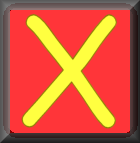
 |
Arithmetic SequencesAn exercise on linear sequences including finding an expression for the nth term and the sum of n terms. |
This is level 1: find the next term of these linear sequences. You can earn a trophy if you get at least 7 questions correct and you do this activity online.
This is Arithmetic Sequences level 1. You can also try:
Matchsticks
Level 2
Level 3
Level 4
Geometric Sequences
InstructionsTry your best to answer the questions above. Type your answers into the boxes provided leaving no spaces. As you work through the exercise regularly click the "check" button. If you have any wrong answers, do your best to do corrections but if there is anything you don't understand, please ask your teacher for help. When you have got all of the questions correct you may want to print out this page and paste it into your exercise book. If you keep your work in an ePortfolio you could take a screen shot of your answers and paste that into your Maths file. |
||
|
|
||
|
|

|
More Activities: |
|
Mathematicians are not the people who find Maths easy; they are the people who enjoy how mystifying, puzzling and hard it is. Are you a mathematician? Comment recorded on the 28 September 'Starter of the Day' page by Malcolm P, Dorset: "A set of real life savers!! Comment recorded on the 28 May 'Starter of the Day' page by L Smith, Colwyn Bay: "An absolutely brilliant resource. Only recently been discovered but is used daily with all my classes. It is particularly useful when things can be saved for further use. Thank you!" |
Each month a newsletter is published containing details of the new additions to the Transum website and a new puzzle of the month. The newsletter is then duplicated as a podcast which is available on the major delivery networks. You can listen to the podcast while you are commuting, exercising or relaxing. Transum breaking news is available on Twitter @Transum and if that's not enough there is also a Transum Facebook page. |
|
AnswersThere are answers to this exercise but they are available in this space to teachers, tutors and parents who have logged in to their Transum subscription on this computer. A Transum subscription unlocks the answers to the online exercises, quizzes and puzzles. It also provides the teacher with access to quality external links on each of the Transum Topic pages and the facility to add to the collection themselves. Subscribers can manage class lists, lesson plans and assessment data in the Class Admin application and have access to reports of the Transum Trophies earned by class members. If you would like to enjoy ad-free access to the thousands of Transum resources, receive our monthly newsletter, unlock the printable worksheets and see our Maths Lesson Finishers then sign up for a subscription now: Subscribe |
||
Go MathsLearning and understanding Mathematics, at every level, requires learner engagement. Mathematics is not a spectator sport. Sometimes traditional teaching fails to actively involve students. One way to address the problem is through the use of interactive activities and this web site provides many of those. The Go Maths page is an alphabetical list of free activities designed for students in Secondary/High school. Maths MapAre you looking for something specific? An exercise to supplement the topic you are studying at school at the moment perhaps. Navigate using our Maths Map to find exercises, puzzles and Maths lesson starters grouped by topic. | ||
Teachers | ||
|
If you found this activity useful don't forget to record it in your scheme of work or learning management system. The short URL, ready to be copied and pasted, is as follows: |
Alternatively, if you use Google Classroom, all you have to do is click on the green icon below in order to add this activity to one of your classes. |
It may be worth remembering that if Transum.org should go offline for whatever reason, there is a mirror site at Transum.info that contains most of the resources that are available here on Transum.org. When planning to use technology in your lesson always have a plan B! |
|
Do you have any comments? It is always useful to receive feedback and helps make this free resource even more useful for those learning Mathematics anywhere in the world. Click here to enter your comments. |
||
© Transum Mathematics 1997-2025
Scan the QR code below to visit the online version of this activity.
https://www.Transum.org/go/?Num=210
Close

Matchsticks - A beginner's exercise that lets you see how a sequence is structured.
Level 1 - Find the next term of these linear sequences
Level 2 - Find the nth term of these linear sequences
Level 3 - Find a given term of these linear sequences
Level 4 - Mixed questions about linear sequences and their sums
Missing Terms - Find the missing terms of arithmetic, geometric and Fibonacci-type sequences in this self marking quiz.
Exam Style questions are in the style of GCSE or IB/A-level exam paper questions and worked solutions are available for Transum subscribers.
Geometric Sequences - A similar exercise on geometric sequences.
Sigma - Practise using the sigma notation to find the sum of various number series.
More on this topic including lesson Starters, visual aids and investigations.
Answers to this exercise are available lower down this page when you are logged in to your Transum account. If you don’t yet have a Transum subscription one can be very quickly set up if you are a teacher, tutor or parent.
See the National Curriculum page for links to related online activities and resources.
Here is a reminder of some facts that may help you answering the questions in this exercise.
An arithmetic sequence, sometimes called an arithmetic progression, is a sequence of numbers such that the difference between the consecutive terms is constant. For instance, the sequence 8, 11, 14, 17, 20, 23, . . . is an arithmetic sequence with common difference of 3.
The first term of the sequence can be written as u1
The nth term of the sequence can be written as un
The common difference is usually written as d
The formula for finding the nth term is un=u1+(n-1)d
The formula for finding the sum of n terms is Sn=½n(2u1+(n-1)d)
Don't wait until you have finished the exercise before you click on the 'Check' button. Click it often as you work through the questions to see if you are answering them correctly. You can double-click the 'Check' button to make it float at the bottom of your screen.
Answers to this exercise are available lower down this page when you are logged in to your Transum account. If you don’t yet have a Transum subscription one can be very quickly set up if you are a teacher, tutor or parent.
Close

Sarah Murphy, Teacher
Monday, February 26, 2024
"For level 2 of this activity, it's not clear how the answer needs to be entered. In the help notes they make reference of things with subscripts. Guidance of the format to enter for the answer is needed.
[Transum: Thanks for your feedback Sarah. For level 2 the answer should be typed in as an expression (no equals sign) in its simplest form. For example, an answer might be '7n' or '5n-2'. No subscripts are required.]"